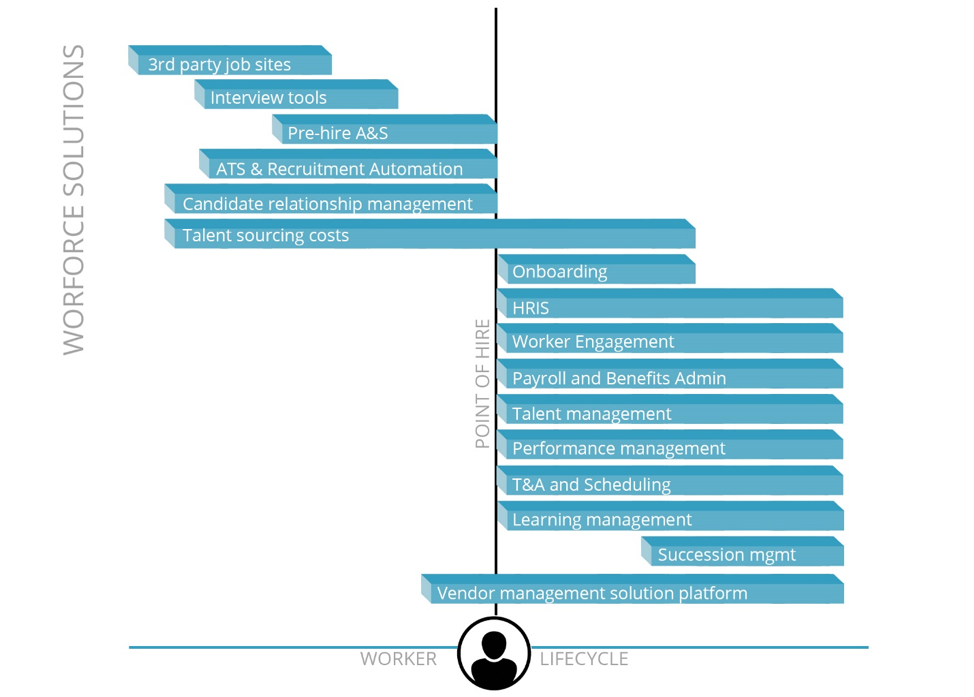Organizations of all sizes capture countless amounts of data across a variety of areas. When you make investments into ERPs and other solutions to manage day-to-day transactions and gain operational efficiencies, you’re aggregating terabytes of valuable data.
Human Resources (HR) and Procurement have mountains of data about their workforces, but often have little understanding of how to derive insight and value from this information. As organizations seek greater business agility, it becomes more important to have the ability to make informed decisions in real-time. Unfortunately, despite having this evidence-based data available to them, many executives are not able to utilize it effectively, thus relying on decision-making based on guesswork, tradition or tribal wisdom.
When it comes to hiring especially, it’s of strategic importance that the firm has the ability to leverage this data to find top talent. With the pressure to identify the right talent (at the right time and the right price) increasing, companies need to have a more holistic view of the candidate journey, which will allow for greater spend visibility, tracking cycle time, identifying workforce gaps and more. And this is essential to close the loop between business strategy, workforce planning and talent acquisition, enabling organizations to overcome skill shortages in a tight talent marketplace and move into a proactive position to drive more value.
So, the question that looms is: how do you turn this huge volume of data into an organizational and strategic asset?
Starting Off: A Few Key Focal Points
Many organizations fail to realize value from their data analytics initiatives, often becoming overwhelmed by the great quantities of data available to them or purchasing sophisticated data and analytics tools without having a true understanding of their requirements and organizational alignment, especially in terms of integration.
To start, here are a few organizational-wide realizations that need to happen:
- Research and precedent support decision-making that is backed by actionable data enables better business outcomes. Building an internal business case to overcome resistance to big data capability investments will help explain how better data harnessing aligns to organizational goals.
- Data tools have to be well-integrated throughout the enterprise, providing the ability to retrieve, share and synthesize data. To manage and measure a strategic talent supply chain sourcing practice, it will be essential to bring together multiple systems and multiple data sources, moving from a reactive to an integrated approach for workforce planning.
- Use your data to map out current state with an honest assessment of the maturity of your HR and contingent workforce management (CWM) programs. Often organizations make the mistake of focusing on data that explains “what” happened, but in doing so miss out on the opportunity to use data to enable the creation of a forward-looking strategy.
- When evaluating business intelligence technology, consider all the types of worker data your organization needs visibility into. For CWM programs in particular, there is enormous complexity since workers and contractors are engaged from a large and growing number of sources. Onboarding the right solution will help business managers make sense of their existing external workforce data by answering questions such as “which staffing supplier provides qualified candidates the fastest?” or “which categories of non-employee worker rates the highest for performance quality”, thus driving analysis and decisions on future labor requirements, workforce segmentation, and internal/external labor market analysis.
- Have more meaningful conversations on buy vs. build for talent sourcing by making the “people conversation” a central part of business planning
Beyond Time-to-Fill
Simply measuring time-to-hire/fill and conversion rates are no longer enough to ensure that talent sourcing processes are delivering a strategic impact. Rather organizations need to look a broader set of recruiting metrics including candidate experience, turnover, quality of hire, source of hire, new worker attrition and contingent talent management process metrics.
To that end, an applicant tracking system (ATS) is not enough. While, the ATS automates the processes and workflows of moving a candidate through the application process, it tends to only capture operationally focused data. Combining the ATS with other solutions (i.e., vendor management system, recruitment marketing, sourcing, new worker onboarding, etc.) will help the organization improve their ability to source and attract the candidates they need. A broader talent acquisition intelligence platform allows companies to gather more valuable data to measure the real impact of talent engagement.

In the end, it goes beyond just HR or procurement metrics, towards aligning metrics with business strategic goals.
Don’t Get Caught Up in the Hype
Artificial intelligence and machine learning are very buzzy right now. However, more and more HR technology leaders are becoming critical about evaluating data analytics tools to ensure they are effective and avoid potential bias (as made famous in that well-publicized
recruiting bias case with Amazon). This means looking beyond the marketing hype and vendor promises to ensure the product can really deliver. When evaluating workforce and market intelligence solutions, be sure to ask providers for validation studies and use cases.
Holistic Workforce Intelligence
Often HR organizations focus their data harnessing on their full-time employees. Yet, as the use of contingent workers continues to grow, many companies are actively trying to determine how to effectively assimilate these workers into their business, thus extending their performance management processes to include non-employees and manage this extended workforce in a way that mitigates compliance risk and lessens administrative burdens.
Whether as part of the core HR system, in a focused vendor management system (VMS), or through a new standalone platform, new technologies can be leveraged to provide business leaders with a unified view of all worker types, helping them manage their contingent workforce more strategically. These systems make it easier to compare labor costs, worker availability, and skill sets across the workforce to ensure the right talent is plugged in where it’s needed. For example, a VMS helps companies automate the process of procuring and managing external workers, including temporary staff, contractors and statement of work consultants. The VMS platform is designed specifically for the purpose of managing contingent talent, giving HR a more holistic view of their entire workforce while helping mitigate compliance risk.
Such platforms also make effective collaboration between HR and procurement functions easier, which is critically important when it comes to contingent workforce management or total talent management (TTM). According to the
2019 Global Human Capital Trends survey by Bersin, Deloitte Consulting, the key to utilizing an alternative workforce more strategically partly lies in connecting different parts to the enterprise more effectively, and unfortunately, procurement, IT and HR often operate in a fragmented manner when onboarding contingent workers.
Workforce Intelligence in the Future of Work
Ultimately, it’s a given that business today (and in the future) will truly run on data. As the way we work evolves, we know that the success of a business will rely on the ability to attain better outcomes through greater visibility and analytical acumen. Since a key component in the future of work is how we utilize talent to optimize how work is done, having the deep workforce intelligence related to talent, spend and suppliers is no longer a desirable aspect, but an absolute imperative capability.








